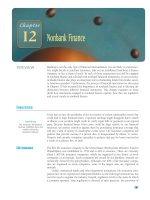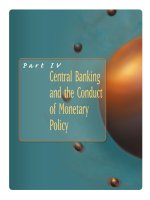Money banking and the financial system 1e by hubbard and OBrien chapter 10
Bạn đang xem bản rút gọn của tài liệu. Xem và tải ngay bản đầy đủ của tài liệu tại đây (496.05 KB, 55 trang )
R. GLENN
HUBBARD
ANTHONY PATRICK
O’BRIEN
Money,
Banking, and
the Financial System
© 2012 Pearson Education, Inc. Publishing as Prentice Hall
CHAPTER
10
The Economics of Banking
LEARNING OBJECTIVES
After studying this chapter, you should be able to:
10.1
Understand bank balance sheets
10.2
Describe the basic operations of a commercial bank
10.3
Explain how banks manage risk
10.4
Explain the trends in the U.S. commercial banking industry
© 2012 Pearson Education, Inc. Publishing as Prentice Hall
CHAPTER
10
The Economics of Banking
WHAT HAPPENS WHEN LOCAL BANKS STOP LOANING MONEY?
• In the recovery from the financial crisis of 2007–2009, banks had
become extremely cautious in making loans.
• Banks were turning away borrowers with flawed credit histories and
avoiding industries that were hard hit by the recession.
• As the value of real estate declined, the collateral that small businesses
could use to borrow against also declined.
• An Inside Look at Policy on page 306 discusses how higher interest
rates may reduce bank profits.
© 2012 Pearson Education, Inc. Publishing as Prentice Hall
Key Issue and Question
Issue: During and immediately following the 2007–2009 financial crisis,
there was a sharp increase in the number of bank failures.
Question: Is banking a particularly risky business? If so, what types of risks
do banks face?
© 2012 Pearson Education, Inc. Publishing as Prentice Hall
4 of 55
10.1Learning Objective
Understand bank balance sheets.
© 2012 Pearson Education, Inc. Publishing as Prentice Hall
5 of 55
• The key commercial banking activities are taking in deposits from savers and
making loans to households and firms.
• A bank’s primary sources of funds are deposits, and primary uses of funds
are loans, which are summarized in the bank’s balance sheet.
Balance sheet A statement that shows an individual’s or a firm’s financial
position on a particular day.
• The typical layout of a balance sheet is based on the following accounting
equation:
Assets = Liabilities + Shareholders’ equity.
The Basics of Commercial Banking: The Bank Balance Sheet
© 2012 Pearson Education, Inc. Publishing as Prentice Hall
6 of 55
The Basics of Commercial Banking: The Bank Balance Sheet
© 2012 Pearson Education, Inc. Publishing as Prentice Hall
7 of 55
Asset Something of value that an individual or a firm owns; in particular, a
financial claim.
Liability Something that an individual or a firm owes, particularly a financial
claim on an individual or a firm.
Bank capital The difference between the value of a bank’s assets and the
value of its liabilities; also called shareholders’ equity.
The Basics of Commercial Banking: The Bank Balance Sheet
© 2012 Pearson Education, Inc. Publishing as Prentice Hall
8 of 55
Bank Liabilities
Checkable Deposits
Checkable deposits Accounts against which depositors can write checks, also
called transaction deposits.
• Demand deposits are checkable deposits on which banks do not pay
interest.
• NOW (negotiable order of withdrawal) accounts are checking accounts that
pay interest.
• Checkable deposits are liabilities to banks and assets to households and
firms.
The Basics of Commercial Banking: The Bank Balance Sheet
© 2012 Pearson Education, Inc. Publishing as Prentice Hall
9 of 55
Nontransaction Deposits
• The most important types of nontransaction deposits are savings accounts,
money market deposit accounts (MMDAs), and time deposits, or certificates
of deposit (CDs).
• Checkable deposits and small-denomination time deposits are covered by
federal deposit insurance.
• CDs of less than $100,000 are called small-denomination time deposits. CDs
of $100,000 or more are called large-denomination time deposits.
CDs worth $100,000 or more are negotiable, which means that investors can
buy and sell them in secondary markets prior to maturity.
Federal deposit insurance A government guarantee of deposit account
balances up to $250,000.
The Basics of Commercial Banking: The Bank Balance Sheet
© 2012 Pearson Education, Inc. Publishing as Prentice Hall
10 of 55
Borrowings
• Banks often make more loans than they can finance with funds they attract
from depositors.
• Bank borrowings include short-term loans in the federal funds market, loans
from a bank’s foreign branches or other subsidiaries or affiliates, repurchase
agreements, and discount loans from the Federal Reserve System.
• Although the name indicates that government money is involved, the loans
in the federal funds market involve the banks’ own funds. The interest rate
on these interbank loans is called the federal funds rate.
• With repurchase agreements—otherwise known as “repos,” or RPs—banks
sell securities, such as Treasury bills, and agree to repurchase them,
typically the next day. Repos are typically between large banks or
corporations, so the degree of counterparty risk is small.
The Basics of Commercial Banking: The Bank Balance Sheet
© 2012 Pearson Education, Inc. Publishing as Prentice Hall
11 of 55
Making the Connection
The Incredible Shrinking Checking Account
Households hold less in
checking accounts relative
to other financial assets
than they once did, partly
due to the wealth effect.
As wealth has increased
over time, households have
been better able to afford
to hold assets, such as
CDs, where their money is
tied up for a while but on
which they earn a higher
rate of interest.
The Basics of Commercial Banking: The Bank Balance Sheet
© 2012 Pearson Education, Inc. Publishing as Prentice Hall
12 of 55
Bank Assets
Bank assets are acquired by banks with the funds they receive from depositors,
with funds they borrow, with funds they acquired initially from their
shareholders, and with profits they retain from their operations.
Reserves and Other Cash Assets
Reserves A bank asset consisting of vault cash plus bank deposits with the
Federal Reserve.
Vault cash Cash on hand in a bank; includes currency in ATMs and deposits
with other banks.
The Basics of Commercial Banking: The Bank Balance Sheet
© 2012 Pearson Education, Inc. Publishing as Prentice Hall
13 of 55
Required reserves Reserves the Fed requires banks to hold against demand
deposit and NOW account balances.
Excess reserves Any reserves banks hold above those necessary to meet
reserve requirements.
• Excess reserves can provide an important source of liquidity to banks, and
during the financial crisis, bank holdings of excess reserves soared.
• Another important cash asset is claims banks have on other banks for
uncollected funds, which is called cash items in the process of collection.
The Basics of Commercial Banking: The Bank Balance Sheet
© 2012 Pearson Education, Inc. Publishing as Prentice Hall
14 of 55
Securities
• Marketable securities are liquid assets that banks trade in financial markets.
• Banks are allowed to hold securities issued by the U.S. Treasury and other
government agencies, corporate bonds that received investment-grade
ratings when they were first issued, and some limited amounts of municipal
bonds, which are bonds issued by state and local governments.
• Because of their liquidity, bank holdings of U.S. Treasury securities are
sometimes called secondary reserves.
• In the United States, commercial banks cannot invest checkable deposits in
corporate bonds or common stock.
The Basics of Commercial Banking: The Bank Balance Sheet
© 2012 Pearson Education, Inc. Publishing as Prentice Hall
15 of 55
Loans
• The largest category of bank assets is loans. Loans are illiquid relative to
marketable securities and entail greater default risk and higher information
costs.
• There are three categories of loans:
(1) loans to businesses—called commercial and industrial, or C&I, loans;
(2) consumer loans, made to households primarily to buy automobiles,
furniture, and other goods; and
(3) real estate loans, including both residential and commercial mortgages.
• The development of the commercial paper market in the 1980s meant that
banks also lost to that market many of the businesses that had been using
short-term C&I loans.
The Basics of Commercial Banking: The Bank Balance Sheet
© 2012 Pearson Education, Inc. Publishing as Prentice Hall
16 of 55
Loans
Figure 10.1
The Changing Mix of
Bank Loans, 1973–2010
The types of loans granted by
banks have changed
significantly since the early
1970s.
Real estate loans have grown
from less than one-third of
bank loans in 1973 to twothirds of bank loans in 2010.
Commercial and industrial
(C&I) loans have fallen from
more than 40% of bank loans
to less than 20%.
Consumer loans have fallen
from more than 27% of all
loans to about 20%.
The Basics of Commercial Banking: The Bank Balance Sheet
© 2012 Pearson Education, Inc. Publishing as Prentice Hall
17 of 55
Other Assets
Other assets include banks’ physical assets, such as computer
equipment and buildings. This category also includes collateral
received from borrowers who have defaulted on loans.
The Basics of Commercial Banking: The Bank Balance Sheet
© 2012 Pearson Education, Inc. Publishing as Prentice Hall
18 of 55
Bank Capital
• Bank capital, also called shareholders’ equity, or bank net worth, is the
difference between the value of a bank’s assets and the value of its
liabilities.
• In 2010, for the U.S. banking system as a whole, bank capital was about
12% of bank assets.
• A bank’s capital equals the funds contributed by the bank’s shareholders
through their purchases of stock the bank has issued plus accumulated
retained profits.
• Note that as the value of a bank’s assets or liabilities changes, so does the
value of the bank’s capital.
The Basics of Commercial Banking: The Bank Balance Sheet
© 2012 Pearson Education, Inc. Publishing as Prentice Hall
19 of 55
Solved Problem
10.1
Constructing a Bank Balance Sheet
The following entries are from the actual balance sheet of a U.S. bank as
of December 31, 2009.
a. Use the entries to construct a balance sheet similar to the one in Table 10.1,
with assets on the left side of the balance sheet and liabilities and bank
capital on the right side.
b. The bank’s capital is what percentage of its assets?
The Basics of Commercial Banking: The Bank Balance Sheet
© 2012 Pearson Education, Inc. Publishing as Prentice Hall
20 of 55
Solved Problem
10.1
Constructing a Bank Balance Sheet
Solving the Problem
Step 1
Review the chapter material.
Step 2 Answer part (a) by using the entries to construct the bank’s balance
sheet, remembering that bank capital is equal to the value of assets
minus the value of liabilities.
The Basics of Commercial Banking: The Bank Balance Sheet
© 2012 Pearson Education, Inc. Publishing as Prentice Hall
21 of 55
Solved Problem
10.1
Constructing a Bank Balance Sheet
Step 3 Answer part (b) by calculating the bank’s capital as a percentage of
its assets.
Total assets = $2,223 billion
Bank capital = $231 billion
Bank capital as a percentage of assets
The Basics of Commercial Banking: The Bank Balance Sheet
© 2012 Pearson Education, Inc. Publishing as Prentice Hall
22 of 55
10.2Learning Objective
Describe the basic operations of a commercial bank.
© 2012 Pearson Education, Inc. Publishing as Prentice Hall
23 of 55
T-account An accounting tool used to show changes in balance sheet items.
The T-accounts below show what happens when you open a checking account
with $100 at Wells Fargo.
In this example, Wells Fargo uses its excess reserves to buy Treasury bills
worth $30 and make a loan worth $60.
The Basic Operations of a Commercial Bank
© 2012 Pearson Education, Inc. Publishing as Prentice Hall
24 of 55
Making the Connection
The Not-So-Simple Relationship between Loan Losses and Bank Profits
• During the term of the loan, if the bank decides that the borrower is likely to
default, the bank must write down or write off the loan.
• Banks set aside part of their capital as a loan loss reserve to anticipate
future loan losses and avoid large swings in its reported profits and capital
from write-offs.
• During the financial crisis of 2007–2009, banks set aside enormous loan loss
reserves as they anticipated write-downs on mortgage-related loans.
• The SEC has argued that banks will sometimes increase their loan loss
reserves more than is justified during an economic expansion, when defaults
are relatively rare. The banks can then draw down the reserves during a
recession, evening out their reported profits.
• If true, this practice would amount to “earnings management,” which is
prohibited under accounting rules because it may give a misleading view of
the firm’s profits.
The Basic Operations of a Commercial Bank
© 2012 Pearson Education, Inc. Publishing as Prentice Hall
25 of 55









